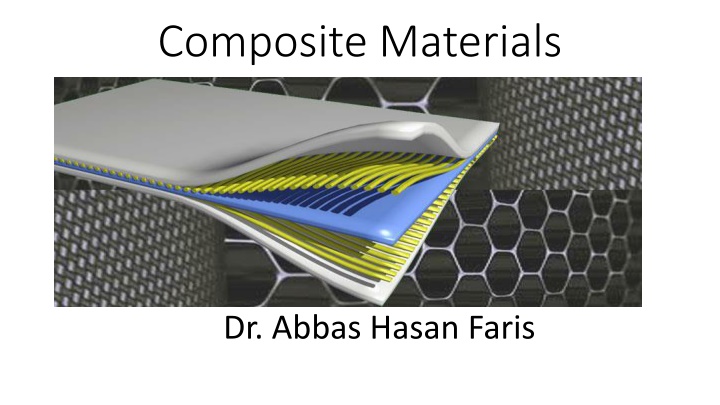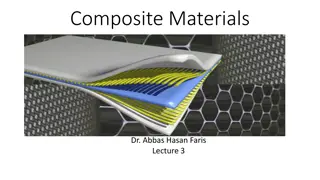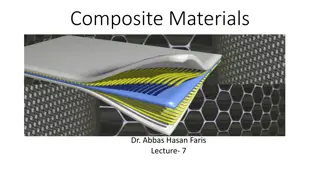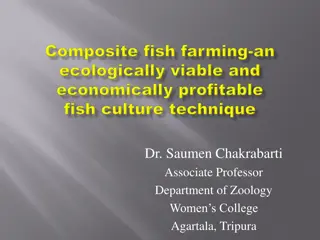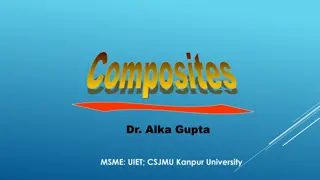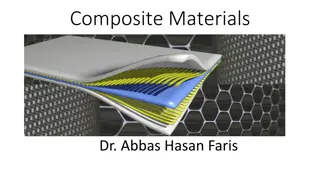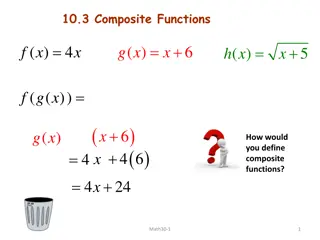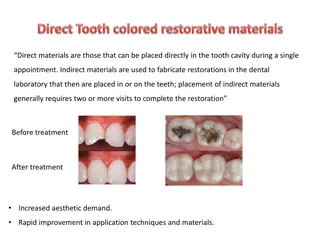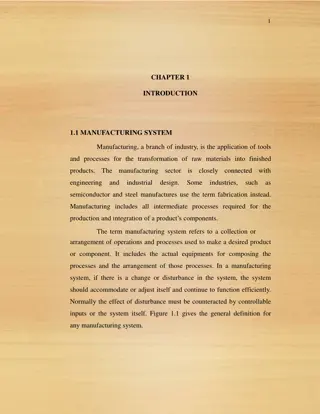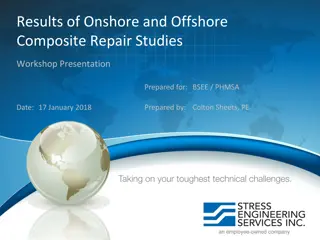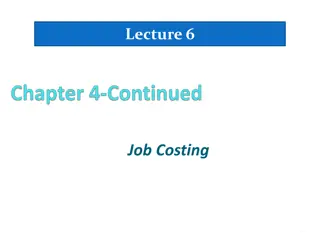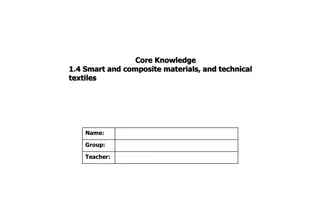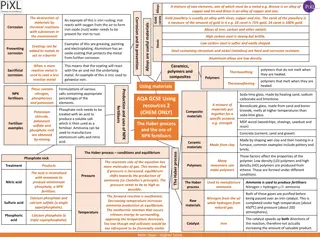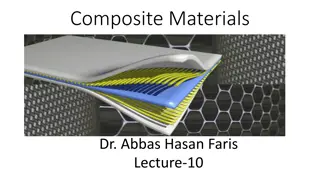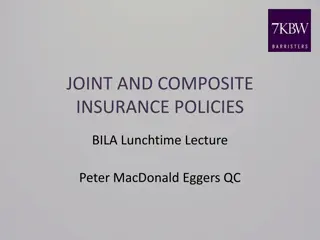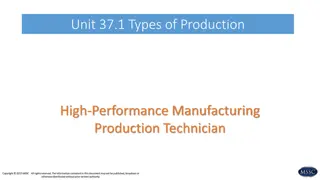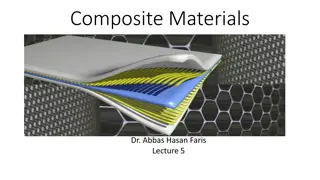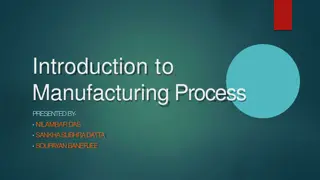Composite Materials Manufacturing Techniques
Composite materials are fabricated using various raw materials and manufacturing processes, each with specific requirements for successful part production. Engineers face challenges in selecting the right technique due to the vast options available. Factors influencing process selection include production rate, cost, performance, size, and shape of the product. The final properties of composite parts differ based on the chosen manufacturing technique, raw materials, and processing conditions.
Download Presentation

Please find below an Image/Link to download the presentation.
The content on the website is provided AS IS for your information and personal use only. It may not be sold, licensed, or shared on other websites without obtaining consent from the author.If you encounter any issues during the download, it is possible that the publisher has removed the file from their server.
You are allowed to download the files provided on this website for personal or commercial use, subject to the condition that they are used lawfully. All files are the property of their respective owners.
The content on the website is provided AS IS for your information and personal use only. It may not be sold, licensed, or shared on other websites without obtaining consent from the author.
E N D
Presentation Transcript
Composite Materials Dr. Abbas Hasan Faris
Manufacturing Techniques Composite production techniques utilize various types of composite raw materials, including fibers, resins, mats, fabrics, prepregs, and molding compounds, for the fabrication of composite parts. Each manufacturing technique requires different types of material systems, different processing conditions, and different tools for part fabrication. Part production success relies on the correct selection of a manufacturing technique as well as the careful selection of processing parameters. Manufacturing Process Selection Criteria It is a monumental challenge for design and manufacturing engineers to select the right manufacturing process for the production of a part, the reason being that design and manufacturing engineers have so many choices in terms of raw materials and processing techniques to fabricate the part.
1. Production Rate/Speed Depending on the application and market needs, the rate of production is different. For example, the automobile market requires a high rate of production, for example, 10,000 units per year (40 per day) to 5,000,000 per year (20,000 per day). In the aerospace market, production requirements are usually in the range of 10 to 100 per year. Similarly, there are composites manufacturing techniques that are suitable for low-volume and high-volume production environments. For example, hand lay-up and wet lay-up processes cannot be used for high-volume production, whereas compression molding (SMC) and injection molding are used to meet high-volume production needs. 2. Cost Factors influencing cost are tooling, labor, raw materials, process cycle time, and assembly time. There are some composite processing techniques that are good at producing low-cost parts, while others are cost prohibitive. The cost of a product is significantly affected by production volume needs as well. For example, compression molding (SMC) is selected over stamping of steel for the fabrication of automotive body panels when the production volume is less than 150,000 per year. For higher volume rates, steel stamping is preferred.
3. Performance Each composite process utilizes different starting materials and therefore the final properties of the part are different. The strength of the composite part strongly depends on fiber type, fiber length, fiber orientation, and fiber content (60 to 70% is the strongest, as a rule). Depending on the application need, suitable raw materials and thus a suitable composite manufacturing technique are selected. 4. Size The size of the structure is also a deciding factor in screening manufacturing processes. The automobile market typically requires smaller-sized components compared to the aerospace and marine industries. For small- to medium-sized components, closed moldings are preferred; whereas for large structures such as a boat hull, an open molding process is used.
5. Shape The shape of a product also plays a deciding role in the selection of a production technique. For example, filament winding is most suitable for the manufacture of pressure vessels and cylindrical shapes. Pultrusion is very economical in producing long parts with uniform cross-sections, such as circular and rectangular. Product Fabrication Needs To make a part, the four major items needed are: 1. Raw material 2. Tooling/mold 3. Heat 4. Pressure
Depending on the manufacturing process selected, a suitable raw material is chosen and spread on the tool/mold. Then, heat and pressure transform the raw material into the final shape. Heat and pressure requirements are different for different material systems. Solid materials such as metals or thermoplastics require a large amount of heat to melt the material for processing, whereas thermosets require less heat. Generally, the higher the melting temperature of a material, the higher the temperature and pressure required for processing.
There are a lot of techniques to cast a composite structure whether it is straightforward or mind-boggling, single or numerous. Every method has its own particular benefits and confinements. The combination of fibers and matrix material is depending upon the final use and required applications in the various field. Other important parameters include temperature, pressure, curing of the matrix, and end-use of the product to form a cost-effective method. The control of these various parameters is a challenge to forming adequate manufacturing techniques for composites. For an adequate chemical reaction, high temperature and pressure are required for highly viscose resins to get adhere and flow inside the fibers so, that good bonding between fiber and matrix material be formed. The chemical reaction of resin forming cross- linking is called curing. The time required to complete the curing is called the cure cycle.
Depending on the manufacturing process selected, a suitable raw material is chosen and laid on the tool/mold. Then, heat and pressure are applied to transform the raw material into the final shape. Heat and pressure requirements are different for different material systems. For example, steel, which melts at 1200 C, requires higher temperatures and pressures to process the part. Aluminum, which melts at around 500 C, requires less heat and pressure for transforming the shape as compared to steel processing. Thermoplastics have melting temperatures in the range of 100 to 350 C and therefore require lesser amounts of heat and pressure as compared to steel and aluminum. Thermosets are in a liquid state at room temperature and therefore are easy to form and process.
There are two main processes for composites manufacturing The difference between open molding and closed molding is in how the resin is cured. When the resin is exposed to the atmosphere during the cure, it is referred to as open molding. When the resin is not exposed to the atmosphere during cure, it is referred to as closed molding.
Open molding resin is impregnated into the fibers and they are placed in an open mold, where they cure or harden. Relatively low cost due to little to no tooling (the mold) can accommodate very large parts with the ability to change mold sizes, (Wide part size potential). Secondary finishing processes are needed as only one side of the finished part will have a good surface finish (the side that was against the mold) Best for low volume production (<1,500 parts per year) as well as large and complex part geometries Closed molding - composite materials are placed in a two-sided mold, closed to the atmosphere Allows for more complex part geometries Produces better parts faster and more consistently than open molding processes Less waste produced More expensive due to tooling (mold) requirements
1. Open molding process: In this process the laminates are exposed to the atmosphere during the process. There are three main methods for impregnating matrix/resins into reinforcement/fibers Types of open mold process Wet lay-up process Spray-up process Filament Winding 2. Close Mold Processes: In this process, the composite is processed in a two-sided mold set, or within a vacuum bag. Fibers and resin cure inside a two-sided mold. Usually require automation and special equipment, for high-volume manufacturing. Types of open mold process Resin Transfer Molding (RTM) Vacuum assisted resin transfer Molding Compression molding Pultrusion Injection molding
Basic Steps in a Composites Manufacturing Process Basic Steps in a Composites Manufacturing Process There are four basic steps involved in composites part fabrication: All composites manufacturing processes involve the same four steps, although they are accomplished in different ways. 1- Impregnation In this step, fibers and resins are mixed together to form a lamina. For example, in a filament winding process, fibers are passed through the resin bath for impregnation. The purpose of this step is to make sure that the resin flows entirely around all fibers. Viscosity, surface tension, and capillary action are the main parameters affecting the impregnation process. Thermosets, which have viscosities in the range of 10 e1 to 10 e4 cp are easier to wet-out. Viscosities of thermoplastics fall in the range of 10 e4 to 10 e8 cp and require a greater amount of pressure for good impregnation.
2- Lay-up In this step, composite laminates are formed by placing fiber resin mixtures or prepregs at desired angles and at places where they are needed. The desired composite thickness is built up by placing various layers of the fiber and resin mixture. The purpose of this step is to achieve the desired fiber architecture as dictated by the design. The performance of a composite structure relies heavily on fiber orientation and lay-up sequence. 3- Consolidation This step involves creating tight contact between each layer of prepreg or lamina. This step ensures that all the entrapped air is removed between layers during processing. Consolidation is a very important step in obtaining a good quality part. Poorly consolidated parts will have voids and dry spots. Consolidation of continuous fiber composites involves two important processes: (1) resin flows through porous media (2) and elastic fiber deformation. During the consolidation process, an applied pressure is shared by both resin and fiber structure. Initially, however, the applied pressure is carried solely by the resin (zero fiber elastic deformation). Fibers go through elastic deformation when the compressive pressure increases and resins flow out toward the boundary.
4- Solidification The final step is solidification, which may take less than a minute for thermoplastics or may take up to 120 min for thermosets. Vacuum or pressure is maintained during this period. The lower the solidification time, the higher the production rate achievable by the process. In thermoset resins, usually the higher the cure temperature, the faster the cross-linking process. In thermoplastics, there is no chemical change during solidification and therefore solidification requires the least amount of time. The above four steps are common in thermoset as well as thermoplastic composites processing.
Advantages of Thermoset Composites Processing The common thermoset resins are epoxy, polyester, and vinylester. These materials could be one-part or two-part systems and are generally in the liquid state at room temperature. These resin systems are then cured at elevated temperatures or sometimes at room temperature to get the final shape. 1. Processing of thermoset composites is much easier because the initial resin system is in the liquid state. 2. Fibers are easy to wet with thermosets, thus voids and porosities are less. 3. Heat and pressure requirements are less in the processing of thermoset composites than thermoplastic composites, thus providing energy savings. 4. A simple low-cost tooling system can be used to process thermoset composites.
Disadvantages of Thermoset Composites Processing 1. Thermoset composite processing requires a lengthy cure time and thus results in lower production rates than thermoplastics. 2. Once cured and solidified, thermoset composite parts cannot be reformed to obtain other shapes. 3. Recycling of thermoset composites is an issue.
Advantages of Thermoplastic Composites Processing The initial raw material in thermoplastic composites (e.g., polyimide (PI), polyetheretherketone (PEEK) is in a solid state and needs to be melted to obtain the final product. 1. The process cycle time is usually very short because there is no chemical reaction during processing, and therefore can be used for high-volume production methods. For example, the process cycle time for injection molding is less than 1 min and therefore very suitable for automotive-type markets where production rate requirements are usually high. 2. Thermoplastic composites can be reshaped and reformed with the application of heat and pressure. 3. Thermoplastic composites are easy to recycle.
Disadvantages of Thermoplastic Composites Processing 1. Thermoplastic composites require heavy and strong tooling for processing. Moreover, the cost of tooling is very high in thermoplastic composites manufacturing processes. For example, the tooling cost in the injection molding process is typically more than $50,000, whereas a mandrel for the filament winding process costs less than $500. 2. Thermoplastic composites are not easy to process and sometimes require sophisticated equipment to apply heat and pressure.
